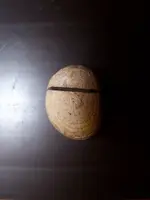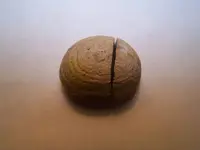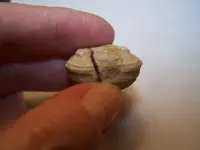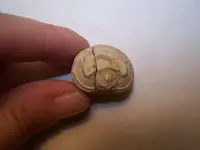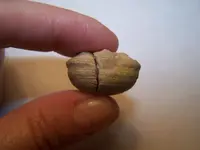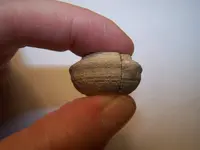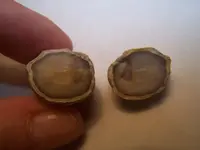Child found this, don't know where or how. Just a rock?
You are using an out of date browser. It may not display this or other websites correctly.
You should upgrade or use an alternative browser.
You should upgrade or use an alternative browser.
Rock? Fossel? Got a name?
- Thread starter martina
- Start date
trikikiwi
Silver Member
- Joined
- Oct 5, 2006
- Messages
- 3,544
- Reaction score
- 655
- Golden Thread
- 0
- Location
- New Zealand
- Detector(s) used
- Minelab Sovereign GT
- Primary Interest:
- All Treasure Hunting
Cool. It appears to be an Agate nodule.
Quote
What Is A Geode?
The mysterious earth-shaped geodes have long challenged geologist to explain how they are formed. Geodes are a variable phenomenon and, therefore, many theories exists to explain how they are created. The term geode is derived from the Greek word Geoides which means "earthlike."
A geode is a sphere shaped rock which contains a hollow cavity lined with crystals. A geode which is completely filled with small compact crystal formations such as agate, jasper or chalcedony is called a nodule. The only difference between a geode and a nodule is that a geode has a hollow cavity, and a nodule is solid.
How Geodes Are Created
Geodes begin as bubbles in volcanic rock or as animal burrows, tree roots or mud balls in sedimentary rock. Over time, the outer shell of the spherical shape hardens, and water containing silica precipitation forms on the inside walls of the hollow cavity within the geode. The silica precipitation can contain any variety of dissolved minerals, the most common being quartz, but amethyst and calcite are also found.
Over a period of thousands of years, layers of silica cool, forming crystals of different minerals within the cavity. Different types of silica cool at varying temperatures, thus creating layers of different types of mineral crystals.
Each geode is unique in composition and can only be truly discovered when cracked open or cut with a rock saw. The size and formation of crystals and different shades of color within the crystals make each geode special. The rough exterior of the geode gives no indication of the secrets held within its core. The anticipation never fades for those who curiously collect buckets full of round geodes and eagerly expose the secrets of each individual sphere-shaped rock. The most prized contain rare amethyst crystals or black calcites.
From here
http://www.freespiritemporium.com/geodes.html
Mike
Quote
What Is A Geode?
The mysterious earth-shaped geodes have long challenged geologist to explain how they are formed. Geodes are a variable phenomenon and, therefore, many theories exists to explain how they are created. The term geode is derived from the Greek word Geoides which means "earthlike."
A geode is a sphere shaped rock which contains a hollow cavity lined with crystals. A geode which is completely filled with small compact crystal formations such as agate, jasper or chalcedony is called a nodule. The only difference between a geode and a nodule is that a geode has a hollow cavity, and a nodule is solid.
How Geodes Are Created
Geodes begin as bubbles in volcanic rock or as animal burrows, tree roots or mud balls in sedimentary rock. Over time, the outer shell of the spherical shape hardens, and water containing silica precipitation forms on the inside walls of the hollow cavity within the geode. The silica precipitation can contain any variety of dissolved minerals, the most common being quartz, but amethyst and calcite are also found.
Over a period of thousands of years, layers of silica cool, forming crystals of different minerals within the cavity. Different types of silica cool at varying temperatures, thus creating layers of different types of mineral crystals.
Each geode is unique in composition and can only be truly discovered when cracked open or cut with a rock saw. The size and formation of crystals and different shades of color within the crystals make each geode special. The rough exterior of the geode gives no indication of the secrets held within its core. The anticipation never fades for those who curiously collect buckets full of round geodes and eagerly expose the secrets of each individual sphere-shaped rock. The most prized contain rare amethyst crystals or black calcites.
From here
http://www.freespiritemporium.com/geodes.html
Mike
Upvote
0
trikikiwi
Silver Member
- Joined
- Oct 5, 2006
- Messages
- 3,544
- Reaction score
- 655
- Golden Thread
- 0
- Location
- New Zealand
- Detector(s) used
- Minelab Sovereign GT
- Primary Interest:
- All Treasure Hunting
I meant to also say "Welcome to TreasureNet" 

Mike


Mike
Upvote
0
SkyPirate
Bronze Member
- Joined
- Mar 31, 2009
- Messages
- 1,861
- Reaction score
- 83
- Golden Thread
- 0
- Location
- Raleigh North Carolina
- Detector(s) used
- Garrett AT Pro, Garrett ProPointer
- Primary Interest:
- All Treasure Hunting
It's a geode.
Upvote
0
Similar threads
- Replies
- 0
- Views
- 193
Users who are viewing this thread
Total: 1 (members: 0, guests: 1)



